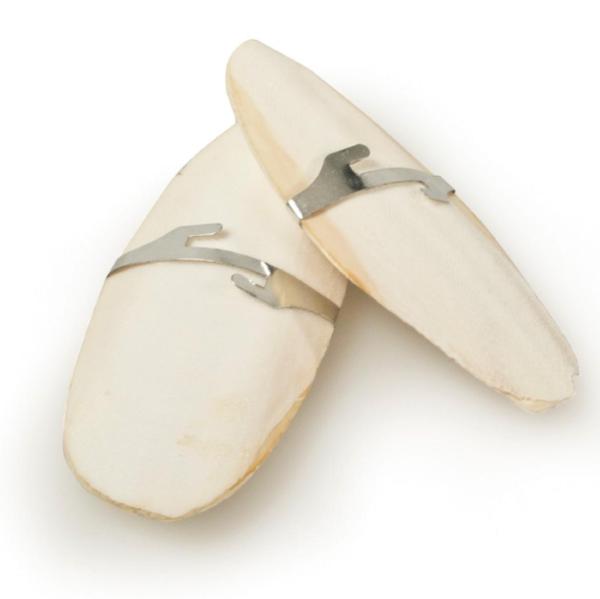
Cuttlefish bone, or cuttlebone, is the inner shell of the cuttlefish, a kind of invertebrate mollusk. Cuttlefish are the only cephalopods that have this kind of shell, as squids have a very different inner structure that resembles a long and very thin cartilage known as squid pen.
This shell is made of aragonite, and it is very appreciated in animal care thanks to its high calcium and mineral salt content. Cuttlebone has a slender and elegant shape that resembles a refined ship design, so it's very easy to recognize.
Keep reading this AnimalWised article and discover all about the nutritional properties of cuttlebone for pets, from birds to reptiles.
What nutrients does cuttlebone have?
Cuttlebone is made of aragonite, that is, crystallized calcium carbonate. This mineral has a beautiful lattice shape, which explains its buoyancy and absorbent power.
Apart from this huge amount of calcium carbonate, cuttlefish shell includes different essential trace elements - withvarying composition percentages - in its composition. Among the nutrients of cuttlebone you can also find calcium phosphate, It also contains calcium phosphate, sodium, magnesium, phosphorus and other mineral salts.

Why is cuttlefish bone good for birds?
Cuttlefish bone is often found in bird cages for birds to nibble on. Do you know why?
The reason why bird enthusiasts have cuttlebone inside their bird's cage is due to the large amount of natural calcium carbonate that makes up the shell. When a bird nibbles on it, its calcium intake is boosted. This is very important, as the diet of birds is naturally deficient in calcium.
Thanks to cuttlebone's highly absorbible natural calcium, their bones get stronger and regenerate. Birds also use cuttlebone to sharpen and wear down their beak, which stops the beak from growing excessively. Moreover, birds that peck at cuttlebone lay higher quality eggs at a faster rate than those birds that don't.
The trace elements also have important properties, and when birds molt their feathers the new ones will be healthier, stronger and more beautiful.

Why is cuttlebone good for turtles and tortoises?
The cuttlebone is a magnificent dietary supplement for turtles and tortoises, especially when they are growing. The composition of turtles' shell and bones requires an adequate supply of calcium, which the cuttlebone can provide.
In the wild, these reptiles naturally absorb calcium by consuming the shells of snails that they come across. Just like with birds, cuttlebone allows turtles and tortoises to sharpen their teeth and control their growth at the same time. The mineral salts provided by the cuttlebone are also good for their organism, so it's understandable why its multiple properties are so beneficial.
Cuttlebone can be placed inside the terrarium for a pet tortoise to peck at. For tortoises and turtles that do not live in terrariums, you can grate the cuttlebone onto its usual food.

Where can you buy cuttlebone for your pet?
Pre-sterilized cuttlebone can be found in any pet food shop. It is a very affordable product, and it is better to go natural than opt for the usual pieces of plastic that are commonly used.
If you're fortunate enough to live near the coast, you may find cuttlefish bone just by walking along the beach. If you don't live near the sea, you'll have no difficulty finding cuttlebone at the fishmongers'.
If you're polite enough to ask, and you also purchase a small amount of cheap fish like sardines or mackerel the fishmonger will usually throw in the cuttlebone for free. However, you can't expect the fishmonger to stop work in order to find a cuttlebone and give it to you for free without buying anything. Obviously, you can always buy a whole cuttlefish.

How to prepare and handle a cuttlebone
Cuttlebone should be boiled for about 10 to 15 minutes to remove the smell of fish and sterilize it. They should then be left to dry in the sun.
It's not recommended to collect and keep too many cuttlebones for future use. Firstly, because they are worn down very slowly by tortoises and birds. Secondly, and very importantly, because the cuttlebone is hydrophilic, that is, it attracts and absorbs moisture from the air. This can cause fungi and bacteria to appear, making it smell bad. For this very reason, it is good to change the cuttlefish bone frequently in reptile terrariums instead of waiting until it is fully worn down.
The best thing to do is to keep cuttlebones in air-tight jars, like those used for keeping biscuits.

If you want to read similar articles to Nutritional Properties of Cuttlebone for Pets, we recommend you visit our Extra care category.